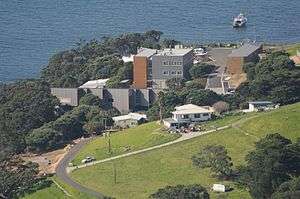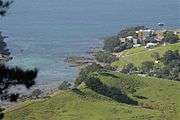Leigh Marine Laboratory
The Leigh Marine Laboratory is the marine research facility for the University of Auckland in New Zealand.[1] The laboratory is situated in north eastern New Zealand, 100 kilometres (62 mi) north of Auckland city. The facility is perched on the cliffs overlooking the Goat Island marine reserve that covers 5 kilometres (3.1 mi) of coastline from Cape Rodney to Okakari Point. The laboratory provides the facilities to support a wide range of field based research, including overnight field trips for undergraduate students and for postgraduate students to live on campus. The laboratory has a fleet of small boats, including a 15 metres (49 ft) long research vessel, Hawere.

History
Leigh Marine Laboratory was opened in 1964 in the small coastal community of Leigh. The first director of the marine laboratory, Bill Ballantine was instrumental in the establishment of the adjacent Goat Island marine reserve in 1975, the first marine protected area in New Zealand.[2] In 2009 a major redevelopment of the Leigh Marine Laboratory began with new facilities being opened in 2010.[3] The new facilities included a new accommodation and workshop building, a three story research building and an interpretive educational centre for public visitors.
Research
A wide range of research activities are undertaken at the laboratory, including marine biogeography, physiology, ecology, genetics, marine fisheries and aquaculture. The laboratory has nine academic staff on site, with seven support staff. Further academic staff from the main University of Auckland campus are also frequent users of the laboratory. Postgraduate research is a major feature of the Leigh Laboratory with more than 400 marine science theses produced from the site.[4]
An important part of research at the Leigh Marine Laboratory is supporting the development of aquaculture in New Zealand.[5] There is a strong focus on the development of new aquaculture species, including spiny lobsters, sea cucumbers, sea urchins, and various fin fish species. In addition, research is undertaken on improving the production and sustainability of existing important aquaculture species, such as abalone, mussels and oysters.
Gallery

Leigh Marine Laboratory overlooking Goat Island 
Leigh Marine Laboratory and surrounding Goat Island marine reserve 
Lobster aquaculture research 
Research on black footed paua Haliotis iris